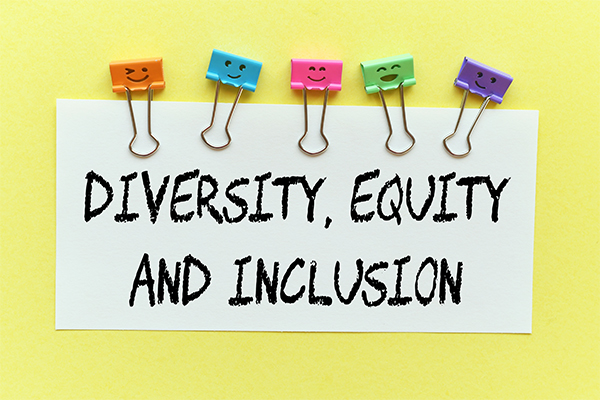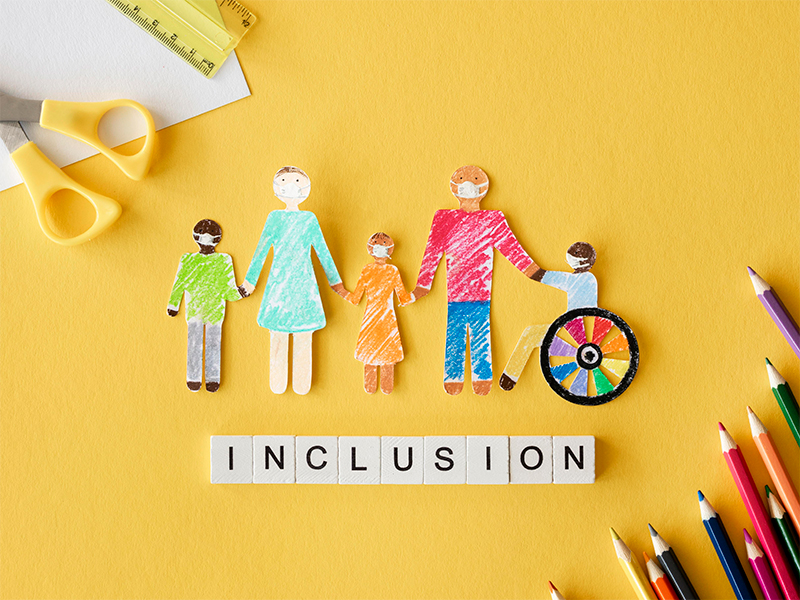Organizations, institutions, and societies are increasingly realizing that diversity and inclusion are ethical imperatives.In today’s rapidly evolving global landscape, the importance of diversity and inclusion has gained significant recognition. Organizations, institutions, and societies are increasingly realizing that diversity and inclusion are not only ethical imperatives but also critical drivers of success and innovation. Diversity encompasses a broad range of dimensions, including but not limited to race, ethnicity, gender, age, sexual orientation, physical abilities, socioeconomic status, and cultural background. Inclusion, on the other hand, focuses on creating an environment that respects, values, and embraces diversity, ensuring that everyone has equal opportunities to participate and contribute.
Promoting diversity and inclusion has several key benefits that positively impact individuals, organizations, and society as a whole. This article delves into the various reasons why diversity and inclusion are crucial in our modern world.
- Enhanced Creativity and Innovation:
When diverse individuals come together, they bring with them unique perspectives, experiences, and knowledge. This diversity of thought sparks creativity and encourages innovative thinking. Different backgrounds and life experiences can lead to fresh ideas, alternative approaches, and out-of-the-box solutions to complex problems. Organizations that foster diverse and inclusive environments are more likely to cultivate an atmosphere of creativity and innovation, giving them a competitive edge in today’s fast-paced and ever-changing global marketplace.
- Expanded Talent Pool:
Embracing diversity and inclusion expands the pool of talent that organizations can tap into. By opening doors to individuals from diverse backgrounds, organizations can access a wider range of skills, experiences, and perspectives. This not only improves the quality of decision-making and problem-solving within the organization but also enhances its ability to understand and cater to diverse customer needs and preferences. Moreover, inclusive hiring practices can attract top talent from different demographic groups, making organizations more attractive and reputable in the job market.
- Increased Employee Engagement and Satisfaction:
Inclusive work environments foster a sense of belonging and psychological safety among employees. When individuals feel valued and respected for who they are, they are more likely to be engaged, motivated, and satisfied in their roles. This, in turn, leads to higher productivity, lower turnover rates, and increased employee loyalty. Employees who feel included are more willing to collaborate, share ideas, and contribute to the overall success of the organization.
- Better Decision-Making:
Research has shown that diverse groups make better decisions compared to homogenous ones. When people with different backgrounds and perspectives come together, they bring a wider range of information, insights, and viewpoints to the table. This diversity of perspectives helps to challenge assumptions, minimize bias, and enhance critical thinking. By considering multiple viewpoints and engaging in constructive debates, organizations can make more well-rounded and informed decisions that are less prone to groupthink or blind spots.
- Improved Problem Solving:
Diverse teams are better equipped to solve complex problems. By drawing on a variety of perspectives and experiences, these teams can approach challenges from different angles and consider a broader range of potential solutions. This diversity of problem-solving approaches increases the likelihood of finding innovative and effective solutions. In today’s interconnected and complex world, organizations need diverse teams to navigate the multifaceted challenges they face.
Visit: tips for social inhibition
- Enhanced Cultural Competence:
Inclusive environments encourage individuals to develop cultural competence and expand their knowledge and understanding of different cultures, traditions, and perspectives. This promotes empathy, reduces prejudice, and fosters a deeper appreciation of diversity. Cultural competence is becoming increasingly important as organizations operate in global markets and interact with diverse stakeholders. By embracing diversity and inclusion, organizations can strengthen their cross-cultural communication skills and build stronger relationships with clients, partners, and communities.
“”An individual has not started living until he can rise above the narrow confines of his individualistic concerns to the broader concerns of all humanity.” – Martin Luther King, Jr
- Social Cohesion and Equality:
Embracing diversity and inclusion goes beyond organizational benefits; it also contributes to a more cohesive and equal society. By valuing and respecting individuals from all walks of life, we create a more inclusive society where everyone has an equal opportunity to thrive. Diversity and inclusion help break down barriers, challenge stereotypes, and promote social justice. When everyone feels included and has a voice, society as a whole benefits from greater harmony and collective progress.
Role of Diversity and Inclusion in Education

The role of diversity and inclusion in education is of utmost importance in preparing students for success in a diverse and interconnected world. Educational institutions play a crucial role in fostering an inclusive environment that values and celebrates diversity, where all students feel respected, supported, and empowered to learn and grow. Here are some key ways in which diversity and inclusion contribute to education:
- Promoting Equal Access to Education:
Diversity and inclusion in education ensure that every student, regardless of their background, has equal access to quality education. It helps break down barriers and create inclusive learning environments where students from different racial, ethnic, socioeconomic, and cultural backgrounds can thrive. By addressing disparities and providing equitable opportunities, education becomes a powerful tool for social mobility and reducing inequality.
2. Enhancing Learning Experiences:
Inclusive education recognizes and respects the diverse learning needs and styles of students. It acknowledges that students have different abilities, interests, and strengths, and aims to create a learning environment that caters to these variations. When diverse perspectives, experiences, and ideas are incorporated into the curriculum, it enriches the learning experiences of all students, fostering critical thinking, empathy, and a broader understanding of the world.
Visit: benefits of supportive parents
3. Fostering Cultural Competence:
Education plays a crucial role in developing cultural competence among students. By exposing students to diverse cultures, languages, and traditions, education nurtures empathy, respect, and appreciation for different perspectives. This helps students develop the skills necessary to navigate and thrive in multicultural societies. Cultural competence also prepares students to interact with individuals from different backgrounds, fostering global citizenship and promoting peaceful coexistence.
4. Challenging Stereotypes and Bias:
Inclusive education challenges stereotypes and biases by providing opportunities for students to learn about and engage with diverse cultures, histories, and experiences. It encourages critical thinking and helps students recognize and challenge stereotypes, promoting a more inclusive and accepting society. By exposing students to diverse perspectives and narratives, education becomes a powerful tool for combating prejudice, discrimination, and inequality.
5. Preparing Students for the Workforce:
In today’s globalized workforce, employers value employees who can effectively collaborate with individuals from diverse backgrounds and contribute to diverse teams. Inclusive education equips students with the skills and mindset necessary for success in the workplace. It fosters teamwork, communication, problem-solving, and adaptability – all of which are essential in a diverse and multicultural professional environment.

6. Empowering Marginalized Communities:
Diversity and inclusion in education empower marginalized communities by providing them with a platform to voice their experiences and perspectives. It helps create a safe and supportive environment for students who may face discrimination or marginalization, allowing them to express their identities and contribute fully to the educational community. Inclusive education gives marginalized students the opportunity to see themselves reflected in the curriculum, promoting a sense of belonging, self-esteem, and empowerment.
Role of Diversity and Inclusion in Workplace

The role of diversity and inclusion in the workplace is crucial for fostering innovation, driving business success, and creating a positive and inclusive work culture. By embracing diversity and creating an inclusive environment, organizations can harness the power of diverse perspectives, experiences, and talents. Here are key ways in which diversity and inclusion contribute to the workplace:
- Enhanced Creativity and Innovation:
Diversity in the workplace brings together individuals with unique backgrounds, experiences, and ideas. This diversity of thought stimulates creativity and encourages innovative thinking. When employees with different perspectives collaborate, they bring fresh insights and approaches to problem-solving, leading to more innovative solutions. Diverse teams are better equipped to navigate complex challenges, adapt to change, and identify opportunities for growth and improvement.
2. Expanded Talent Pool and Improved Recruitment:
Embracing diversity and inclusion expands the talent pool from which organizations can recruit. By actively seeking candidates from diverse backgrounds, organizations can access a wider range of skills, experiences, and perspectives. This promotes diversity at all levels of the organization, including leadership positions. Inclusive recruitment practices also help attract top talent from different demographic groups, making the organization more competitive and appealing to prospective employees.
Visit: crony capitalism vs Oilgarchy
3. Increased Employee Engagement and Retention:
Inclusive workplaces foster a sense of belonging and psychological safety, where employees feel valued, respected, and supported. When employees feel included and appreciated for their unique contributions, they are more engaged, motivated, and committed to the organization’s success. Inclusive practices also reduce turnover rates, as employees are more likely to stay in an organization where they feel supported and have equal opportunities for growth and advancement.
4. Improved Decision-Making and Problem-Solving:
Diverse teams bring together individuals with different backgrounds, perspectives, and expertise. This diversity of viewpoints enhances decision-making and problem-solving processes. When employees with varied experiences and knowledge collaborate, they challenge assumptions, minimize bias, and consider a wider range of possibilities. Diverse teams are more likely to make well-rounded, informed decisions and find innovative solutions to complex problems.
5. Enhanced Customer Understanding and Satisfaction:
In a diverse and globalized marketplace, organizations that reflect the diversity of their customer base are better equipped to understand and meet customer needs. Diverse teams bring a range of cultural insights and perspectives, enabling organizations to develop products, services, and marketing strategies that resonate with diverse audiences. This leads to improved customer satisfaction, loyalty, and a competitive advantage in the market.

Statistics for Diversity and Inclusion
Here are some statistics that highlight the benefits of diversity and inclusion in various aspects of organizations:

- A study by McKinsey & Company found that companies in the top quartile for gender diversity on executive teams were 25% more likely to have above-average profitability compared to companies with lower diversity.
- Another study by McKinsey revealed that companies with ethnically diverse executive teams were 36% more likely to outperform their industry peers in terms of profitability.
- A report by the Peterson Institute for International Economics showed that organizations with more women in leadership positions had a 15% higher net profit margin compared to those with no female leaders.
- According to research conducted by the Boston Consulting Group, diverse companies have higher innovation revenue, generating 19% more revenue from innovation than less diverse organizations.
- A study published in the Harvard Business Review found that diverse teams are more likely to solve complex problems faster and with better results than homogeneous teams.
- A research study by Cloverpop revealed that inclusive decision-making teams make better decisions 87% of the time.
- A Glassdoor survey showed that 67% of job seekers consider a diverse workforce an important factor when evaluating job offers.
- The Society for Human Resource Management (SHRM) found that organizations with inclusive hiring practices have a 49% higher retention rate of diverse employees.
- Deloitte’s Global Human Capital Trends survey indicated that 69% of executives surveyed rated diversity and inclusion as a top priority for talent acquisition.
- According to a survey conducted by Accenture, 29% of consumers are more likely to switch to a brand that demonstrates a commitment to diversity and inclusion.
- A study by the Center for Talent Innovation found that companies with inclusive cultures were 80% more likely to capture new markets.
Visit: blockchain trends to follow
How India Signifies Diversity and Inclusion?

India is a country known for its rich cultural diversity and traditions, which contribute to its emphasis on diversity and inclusion. Here are several ways in which India signifies diversity and inclusion:
- Cultural Diversity: India is home to a vast range of religions, languages, and ethnicities. Its population consists of Hindus, Muslims, Sikhs, Christians, Buddhists, Jains, and various other religious communities. This diversity is reflected in the country’s festivals, customs, traditions, and cuisine.
- Constitution and Laws: India’s Constitution guarantees equality and prohibits discrimination based on religion, race, caste, sex, or place of birth. The Constitution also reserves seats in legislatures and educational institutions for marginalized groups, such as Scheduled Castes, Scheduled Tribes, and Other Backward Classes, to ensure their representation.
- Reservation Policy: India has implemented affirmative action policies, commonly known as reservation, to promote inclusivity and address historical disadvantages faced by marginalized communities. These reservations provide quotas in government jobs, educational institutions, and other sectors to ensure representation and equal opportunities for underprivileged groups.
- Unity in Diversity: India’s national motto, “Unity in Diversity” (in Sanskrit: “Vasudhaiva Kutumbakam”), encapsulates the spirit of inclusiveness. Despite its diverse population, India strives to maintain unity and harmony among different religious, linguistic, and cultural groups.
- Celebrating Festivals: India celebrates various festivals throughout the year, representing different religions and communities. Festivals like Diwali, Eid, Christmas, Holi, Navratri, and Baisakhi bring people from diverse backgrounds together, fostering cultural exchange, understanding, and harmony.
- Regional Variations: India’s different states and regions have their own distinct languages, cuisines, arts, and traditions. These regional variations add to the country’s cultural tapestry and showcase the inclusiveness of different identities within India.
- Bollywood and Art: Indian cinema, particularly Bollywood, is renowned worldwide for its vibrant and diverse storytelling. Bollywood movies often feature actors from different ethnic backgrounds, religions, and regions, emphasizing the inclusiveness of the industry. India’s art, literature, and music also showcase the country’s diverse cultural expressions.
- Government Initiatives: The Indian government has launched various initiatives to promote diversity and inclusion. For example, the “Accessible India Campaign” aims to make public spaces and services accessible to persons with disabilities, while the “Beti Bachao, Beti Padhao” (Save the Girl Child, Educate the Girl Child) initiative focuses on empowering girls and reducing gender discrimination.
While India has made progress in promoting diversity and inclusion, challenges remain, particularly related to gender inequality, caste discrimination, and religious tensions. However, the country’s commitment to inclusivity and the ongoing efforts to address these issues demonstrate its significance as a diverse and inclusive nation.

